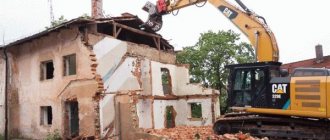If you need to agree on the transfer of non-residential premises to residential ones or, conversely, to transfer residential premises to non-residential ones, we will help.
The approval procedure is not as simple as it might seem, and it is difficult for an ignorant person to understand all the vicissitudes of the issues. The fact is that there are a lot of nuances in the legislation that permit or prohibit translation - and without knowledge of these nuances, you easily risk losing precious time and money.
In addition, during the translation process it will be necessary to collect and prepare a lot of documents and papers, on the basis of which, in the end, the final decision on approval will be made.
Please note that the approval of the transfer to residential/non-residential stock is carried out by the MVK Department of Housing Policy and Housing Fund of Moscow.
Time limit for obtaining permission to transfer to a non-residential property from the Interregional Institutions Committee of the Department of Housing Policy and Housing Fund of Moscow: from 4 to 6 months
. This is due to the fact that before receiving the main document approving the translation, it is necessary to undergo step-by-step approval in a number of specialized authorities.
Here are the main coordinating authorities:
1) Main Directorate of the Ministry of Emergency Situations of Russia for Moscow; 2) Office of Rospotrebnadzor for Moscow; 3) State Unitary Enterprise "GlavAPU" (Main Architectural and Planning Department of the Moscow Committee for Architecture and Architecture); 4) State Unitary Enterprise “Mosgorgeotrest” (“Moscow City Trust for Geological, Geodetic and Cartographic Works”); 5) Author of the house project; 6) DEZ (“Directorate of a single customer”); 7) GU IS (State Institution of Engineering Service); Moszhilinspektsiya (“State Housing Inspectorate of the City of Moscow”), etc.
2) Office of Rospotrebnadzor for Moscow; 3) State Unitary Enterprise "GlavAPU" (Main Architectural and Planning Department of the Moscow Committee for Architecture and Architecture); 4) State Unitary Enterprise “Mosgorgeotrest” (“Moscow City Trust for Geological, Geodetic and Cartographic Works”); 5) Author of the house project; 6) DEZ (“Directorate of a single customer”); 7) GU IS (State Institution of Engineering Service); Moszhilinspektsiya (“State Housing Inspectorate of the City of Moscow”), etc.
The approval process in each of these departments has its own nuances, so it is simply impossible to do without experience in interacting with employees of these departments.
According to the Housing Code of the Russian Federation, approval of a transfer from residential to non-residential stock should be refused in the following cases:
If the premises are part of an integral residential premises or are used for permanent residence; - if access to the premises being transferred is impossible and there is no technical possibility to equip this access; - if the ownership of the transferred premises is encumbered by the rights of other individuals or legal entities (in particular, if the premises are the subject of a pledge).
The following requirement is established for apartments in residential multi-apartment buildings. To transfer one of them to non-residential premises, it is necessary that it be located on the first floor, or above the first floor (provided that there are non-residential premises above it).
Regarding the transfer of non-residential premises to residential premises, the following conditions apply:
The premises being transferred must meet the requirements for residential premises under the current legislation of the Russian Federation; - ownership of it should not be encumbered by the rights of third parties, individuals or legal entities.
We also note that in accordance with the Decree of the Moscow Government of October 25, 2011, when installing a separate entrance (including when transferring from residential premises to non-residential premises), a decision of the general meeting of owners of residential and non-residential premises in apartment buildings on transfer to use of part of the common property (at least 2/3 of the total area of residential and non-residential premises of the house).
What documents will you need in order to approve the translation?
1. Application from the owner or authorized person to transfer the premises. 2. Documents confirming the right to the premises being transferred (originals or notarized copies). 3. Floor plan, its technical description. When transferring a residential premises, you will also need its technical passport. 4. Floor plan of the house: “floor plan of the first floor, premises adjacent to the apartment”, “plan of the second floor of the premises located above the apartment”, “plan of the basement located under the apartment”. 5. Project of reconstruction and (or) redevelopment, prepared in accordance with the established procedure (if any are required).
For additional questions, please contact our specialists.
Dear friends! We provide a wide range of services for the design and coordination of various documentation regarding the redevelopment of real estate in Moscow. Our employees have undergone good training in real estate, design, and construction organizations and have accumulated a wealth of experience in their field. Since 1995, we have resolved hundreds of issues, simple and complex, so today we confidently declare: “With us you will save your time and money.”
Residential means real estate that provides all the conditions for permanent residence and meets all required standards. Non-residential is considered to be one in which there are no conditions necessary for life. These are: offices, shops, country houses, factory workshops, warehouses and the like.
Important
Dachas located outside the city limits and other populated areas cannot be converted into residential premises, since they are located on lands intended for agricultural needs.
Owners of real estate that has non-residential status can re-register it if they wish. In order to convert non-residential premises into residential
, the personal initiative of its owner is required. It will be impossible to do this without her. If the property is owned by shared owners, all co-owners are required to draw up a corresponding statement, which must then be certified by a notary.
Before converting non-residential premises to residential
, you need to make sure that it is not mortgaged or under arrest. If the property is on credit, then before the transfer is made it must be fully paid and all debts repaid. Everything that is in it must be in good working order, technical standards must be met, and the room itself must be equipped with minimal household amenities.
Sometimes the question arises whether it is possible to convert residential premises into non-residential ones. This can also be done in compliance with the law, although this happens much less frequently.
How to convert non-residential premises into residential ones: step-by-step instructions
Once the commission has determined that the premises are suitable for transfer from non-residential to residential, all necessary measures (repairs, redevelopment) have been observed, it is time to begin the formalization of the procedure itself.
To carry out the transfer of any non-residential premises to residential premises, conditions and procedure
which are defined by housing legislation, first of all, it is necessary to collect documents. The following are mandatory:
- passport of the property owner;
- an application requesting the transfer of premises from non-residential to residential;
- the applicant’s title documents for the real estate being re-registered;
- conclusions of the SES and housing services on the compliance of the area with the required standards;
- floor plan of the building on which the premises are located;
- (on demand);
- if redevelopment is necessary, the corresponding project.
If the right to build is registered in the Unified State Register, an application and a redevelopment project will be sufficient, if required to comply with the standards. If you think that a mistake was made during the assessment, you can go to court.
After all the documents have been collected, they must be submitted to the multifunctional legal center or directly to the municipality where the property is registered. The contents of the document package is recorded by the person who accepted it, and the applicant is given a corresponding certificate with a signature. This is followed by the practical stage of converting non-residential premises into residential premises. By the way, you may find information on .
Sometimes a property may not be considered suitable for habitation and may require changes to the layout, etc. In this case, it is necessary that the owner initiating the re-registration of the area must carry out repairs in accordance with the approved plan, agreed upon with the municipality.
Then all changes that were made during the redevelopment are included in the technical documents and documents confirming ownership. Such difficulties are necessary when complex redevelopment is required. If the changes are minor, you can add them to the construction plan yourself.
It is useful to learn about the possibilities of reducing this type of penalty.
Galina Khovanskaya, the author of the law banning hostels in residential premises, is now going to expel the rest of the business from apartment buildings. She has prepared a legislative initiative that will require entrepreneurs to coordinate the use of non-residential premises with their neighbors.
Everything is explained by concern for the peace of citizens. “Often the first floors of the housing stock are transferred to non-residential stock, and entrepreneurs, regardless of the interests of residents, open shops, cafes, sports, music and dance clubs there. All this brings a lot of inconvenience to residents: unsanitary conditions, loading/unloading in the yard, preventing residents from resting comfortably both in their apartment and on the street, noise from operating industrial air conditioners, and much more.
I believe that apartment buildings are designed for comfortable living. While at home, residents should not experience stress from noise, smell unpleasant odors, or “fight” rodents and insects. They should rest first! It is necessary to coordinate the use of non-residential premises with residents of apartment buildings. What will be in them should be openly decided by the residents!
The corresponding legislative initiative has been prepared,” Galina Khovanskaya said on her Facebook. The approval itself, in her opinion, should go through a general meeting of owners according to the same principle as when transferring premises from residential to non-residential, it is necessary to obtain the consent of two thirds of the apartment owners.
At the same time, Khovanskaya claims that the law will only regulate new businesses that want to open in an apartment building. “We do not touch situations that have developed historically. There are other structures working there. The business that is already operating will remain,” the parliamentarian explained.
Both residents of apartment buildings and entrepreneurs are actively discussing the initiative on social networks. Gulnara Borisova, president of the St. Petersburg Association of Home Owners and Their Associations, says: “Residents of the houses also call and write to me a lot, screaming for help. This is exactly what entrepreneurs answer: this is my premises - I do whatever I want. And I will work as I want - both at night and on weekends. So, maybe the reason for the appearance of such a bill should not be sought in Khovanskaya, but in the lack of culture, moral and social irresponsibility of our business.”
Artem Gudchenko, President of the Renta Group of Companies: “An absolutely dead-end idea, the desire of the legislator to imitate democracy where it is not needed. To make residents feel comfortable, government regulation needs to be tightened up. Existing legislation regulates sanitary standards and the condition of commercial premises in residential buildings, Rospotrebnadzor forms the types of activities that are permitted or not permitted in residential buildings, Technical Supervision bodies ensure compliance with safety standards and proper operation of all systems in the house, in addition, there are building codes and regulations, in a word, there is a large cluster of legislative standards that regulates both the construction and operation of commercial premises in residential buildings.
And if suddenly there is a discrepancy between the needs of the population and business, the rules change, they need to be modernized. But our officials can’t cope, so let’s create people’s squads. Such initiatives can replace the police, public education and even healthcare. Voting can be used to make decisions in clinics. This possible bill is a Pandora's box; once opened, it will be difficult to close. Once they have received such rights, residents will perceive them as natural. Decisions will be made according to the principle: my home is my fortress - and, figuratively speaking, to stand with axes at the boundary. People cannot agree on something in a three-room communal apartment, how can they agree in a building with 500 apartments?
If such a rule is adopted, the commercial real estate market will lose a large number of commercial premises. It is impossible to replace all the shops, cafes and beauty salons on the streets with free-standing shopping malls. Service and the opportunity to make necessary purchases and receive services should be within walking distance. TCs serve more of an entertainment function.
The proportions of retail and service premises in residential buildings and shopping malls are now 4:1. That is, the area of shopping complexes is 4 times smaller. This is a huge blow to the market and the economy. In addition, 70% of commercial premises are occupied by small and medium-sized businesses. To open any business now—a store, a pharmacy, a beauty salon—you have to overcome a lot of difficulties. It is very difficult to make a business profitable, and even if you go through approvals with residents, some of them do not live, some are abroad, some are in prison. There will be a huge number of empty premises. The infrastructure of cities is deteriorating. And the quality of life of city residents depends not only on the greenery in the yard and the playground, but on the entire infrastructure.”
Nadezhda Bagrets, dry cleaner “O-TRI”, member of the Moscow Council of Entrepreneurs: “This bill was discussed at the Council of Entrepreneurs, and there was serious opposition to it in the business environment. The draft law will not be left without attention.”
We issue a new certificate of ownership
When the redevelopment is done and the documents are collected, it's time to submit an application. After this, within forty-eight days from the date of its submission, a response is received from the state property department with either consent or refusal.
Important
In case of a negative decision, you can appeal it in court within three months from the date of receipt of the notice.
As soon as the notification that non-residential premises are allowed to be converted into residential premises, it is necessary to obtain a new cadastral passport for it, a floor plan (both must be taken from the BTI), and a certificate of ownership. In order to obtain a new title document for real estate, you need to provide:
- statement;
- copy of passport;
- existing ownership documents;
- BTI certificates;
- receipt for payment of state duty.
The application along with the documents is submitted either to Rosreestr or to the multifunctional center, after which a new registration will be issued within ten days from the date of submission. It is useful to know and why is this document necessary? By the way, if you want, find out how to do it correctly.
Quite often, entrepreneurs purchase apartments on the first floors of residential buildings, which are then transferred to non-residential stock. Is it possible to convert non-residential premises into residential premises and what is necessary for this? The specialists of the architectural bureau “World of Projects” are ready to answer this and many other questions!
What documents are required to approve an additional entrance?
How to design an entrance group if this is necessary to support activities in a non-residential premises? The entrance group in an apartment building is initially provided for by the project. It is needed for residents and other persons to have access to apartments, non-residential premises, and common areas. For non-residential premises that are used for business activities, a separate exit to the street or staircase is almost always needed. In this case, the entrance group in an apartment building is made according to the redevelopment project. In some cases, such work may fall under reconstruction.
The entrance group includes not only a doorway and a porch, but also supports, fastenings, ramps and fences for people with limited mobility.
To determine how the approval of an additional entrance to the premises will take place, you need to take into account the following nuances:
Dear Clients!
The information in this article contains general information, but each case is unique. You can get a free consultation from our engineers using one of our telephone numbers - call:
8 Moscow (our address)
8 St. Petersburg (our address)
All consultations are free.
- if the owner of the premises arranges an additional doorway within the apartment (for example, creates an entrance between rooms), the work relates to redevelopment and is subject to approval based on the project and technical report;
- if an additional entrance is being built for a residential premises on the ground floor of an apartment building, this type of work may relate to redevelopment, and upon approval it is necessary to obtain permission from the owners of the house (in both Moscow and St. Petersburg the approval procedure is similar - the differences are in which authorities the authorities are vested with separate approval powers);
- if an additional entrance needs to be installed in a non-residential building, it is necessary to agree on a design solution to change the appearance of the façade of the property and develop the technical documentation necessary for professional performance of the work.
Note! If the owner of an apartment transfers it to a non-residential property, arrangement and approval of an additional entrance is a prerequisite. The law establishes a ban on leaving non-residential premises in an apartment building to stairwells or other internal common areas. Registration of the entrance to non-residential premises on the 1st floor of an apartment building is a mandatory condition established by the Housing Code of the Russian Federation.
Most often, a separate entrance is made to non-residential premises.
This is necessary to conduct business. According to the norms of the Housing Code of the Russian Federation, if reconstruction or redevelopment is impossible without joining the common property of an apartment building, the consent of the owners of the house must be obtained to carry out the work. For this purpose, a general meeting is convened and held, the results of which are entered into the minutes. To resolve the issue positively, it is necessary to obtain the consent of 2/3 of all owners.
It should be taken into account that an additional entrance can only be installed for premises on the first or second floor. Decree of the State Construction Committee of Russia No. 170 () includes the installation of doorways as part of the redevelopment. However, this rule applies to interior work. In some cases, the design of the entrance is associated with changes to the facade or load-bearing elements; it may be recognized as reconstruction - in this case, simple approval is not enough, you will have to obtain permission to carry out construction work from the supervisory authorities. Making an entrance group in an apartment building is a complex bureaucratic procedure, and the result of such work is clearly visible to others, including housing inspectors and supervisory authorities. For uncoordinated actions to construct a separate entrance to an apartment building, the owner of the premises is subject to liability in accordance with the norms of the Administrative Code.
| No. | Documents used when approving the entrance group | Description |
| 1 | Title document | Only the owner can carry out redevelopment. The title document can be an extract from the Unified State Register of Real Estate, a certificate of title |
| 2 | Owners' consent | The consent of all owners of the premises is required for redevelopment. Consent must be formalized in writing and submitted for approval. |
| 3 | Redevelopment project | The project contains a description of all redevelopment work and requirements for their safety. The project can be produced by an organization consisting of SRO designers. |
| 4 | Technical conclusion | The technical report describes the condition of the load-bearing structures for redevelopment. Based on the results of the inspections, the technical report draws a conclusion about the admissibility of the work, and draws up calculations for loads and structural reinforcements. |
| 5 | Acceptance committee report | The act is drawn up in the Moscow Housing Inspectorate after completion of the work. Specialists will check that redevelopment solutions comply with the project and technical conclusion. |
| 6 | Technical plan. | The main document on the basis of which the object is placed on cadastral registration with information entered into the Unified State Register of Real Estate. After redevelopment, the technical plan indicates the new characteristics of the room. The technical plan is prepared by a cadastral engineer after examining the building. |
What documents will be needed
The documents that will be required to approve the entrance to an apartment building include the following forms:
- title documents for an apartment or non-residential premises - certificate of title, extract from the Unified State Register, etc.;
- a redevelopment project prepared by an expert organization with a valid SRO permit;
- a positive technical conclusion on the condition of the load-bearing elements and components of the building (this document is required only when approving the entrance to an apartment building in Moscow; in other regions this requirement is not present);
- minutes of the general meeting of owners of the apartment building, which confirms permission to arrange an additional entrance, if such consent is required (in each specific case, the need to obtain the consent of the owners is determined individually);
- act of acceptance of completed work, confirming compliance of the characteristics of the additional input with the design documentation;
- a technical plan, which will reflect changes in the characteristics of the premises and the building, and which also includes all approval documents on the arrangement of a separate entrance to the building;
- identification documents of the owner (passport, birth certificate) or his representative (power of attorney);
- consent of all owners of the premises to arrange an additional entrance.
Requirements for residential premises
The Regulations on recognizing premises as residential contain the following requirements:
- The premises must be located in houses in a residential area, in accordance with the functional zoning of the territory;
- Enclosing and load-bearing structures, including those related to the common property of the owners of an apartment building, must be in working condition in which violations that occur during operation do not harm the reliability of the building and ensure the safety of utilities and the safe stay of residents.
- The premises must have engineering systems (gas supply, drainage, water supply, electric lighting). Engineering systems (elevators, drainage, heating, ventilation, etc.), mechanisms and equipment that are located in residential premises and are part of the common property of owners of apartment premises houses must meet sanitary and epidemiological safety conditions.
- Engineering systems (ventilation, heating, water supply, drainage, elevators, etc.), equipment and mechanisms that are located in residential premises, and also belong to the common property of the owners of premises in an apartment building, must comply with sanitary and epidemiological safety requirements.
- Residential premises must be protected from penetration of ground, melt and rain water. As well as other water leaks from engineering systems using technical devices and design means.
Contents and design of the document
Most often, the survey is carried out using a regular piece of paper on which the owners of residential premises put their signatures for approval.
Consent/disagreement form:
- The heading “Consent” is placed in the center of the sheet.
- A transcript is written under the title. Example: “for reconstruction, reorganization and (or) redevelopment of premises, as a result of which part of the common property in an apartment building will be added to them.”
- Place, date.
- Data of the owner who gives consent, incl.
Full name, address of the residential premises, details of the certificate of ownership. Example: “(full name), being the owner of premises in an apartment building located at (address of the house and apartment), as confirmed by Certificate of Ownership No. (number) dated (date of issue of the certificate), valid on the basis of Part 2 of Article 40 The Housing Complex of the Russian Federation hereby gives consent to the reconstruction and redevelopment of the premises, as a result of which part of the common property of the apartment building will be added to them.” - Signature and decryption of the signature.
Required documents
To transfer non-residential premises to residential premises, the applicant (owner or authorized person) must submit the following documents to the authorized body:
- Title documentation for the premises (originals and notarized copies);
- Application for transfer of premises;
- Plan and technical description of the premises being transferred;
- Floor plan of the building in which the premises being transferred are located;
- A project for redevelopment and reconstruction of the transferred premises developed and executed in accordance with the established procedure (if any are necessary to ensure its operation as a residential one).
The specified list of documentation is complete, that is, the applicant does not need to provide any other documents. When accepting documents, the authorized body issues a receipt to the applicant, which serves as proof that the documentation has been submitted in full.
The decision to transfer or refuse to transfer is made based on the results of consideration within forty-five days from the date of submission of the documentation.
Non-residential premises: what will the neighbors say?
In the previous issue, we talked about the difficulties entrepreneurs have to face when converting residential premises to non-residential ones. Most of the legal proceedings related to this issue are initiated not by the citizens themselves, who for one reason or another were refused to place their office in an apartment building, but by its other residents.
Sometimes citizens are afraid for fire safety and, remembering the ancient wisdom “It is better to prevent a fire than to put it out,” they go to court with a request to rid them of a flammable neighborhood. Many people don’t like the noise of clients’ cars driving up to the office from morning to evening. And someone discovers that after the store opened, the former cleanliness disappeared in the yard and even rats appeared. Situations are different, and company management does not always win in such disputes.
It would seem that the fewer neighbors, the less hassle. But even if there is only one neighbor, this does not guarantee the ability to do everything you want. This was confirmed by the Gorno-Altai City Court of the Altai Republic, having considered a civil case on the claim of B. against A. to terminate the operation of the store located in the house and invalidate the permits for the reconstruction and commissioning of the facility.
Citizen B. was the owner of a residential apartment in a one-story, two-apartment building with a plot of land. One day he saw that his neighbor A. had placed a sign for an auto parts store above her entrance. Having become interested in the legality of her actions, the man learned that an “authorized” reconstruction had already been carried out in the neighbor’s apartment and the local administration had authorized her transfer to non-residential premises.
Since the residential building was wooden, had a common basement and fairly thin walls, the plaintiff immediately realized that such a neighborhood would cause discomfort: due to the work of the store, noise and smells would constantly disturb the residents, cars would be parked near the store, which would block the passage to the building, In addition, fuels and lubricants can ignite at any moment. After making the decision to transfer residential premises to non-residential premises, the local government body did not inform the owner of the premises adjacent to the one being transferred about its decision. There was no certificate from the acceptance committee after redevelopment of the apartment into non-residential premises. The land plot on which the store is located had the type of permitted use “for personal farming”, which was not changed.
Defendant A. did not agree with the plaintiff’s demands, pointing out that the reconstruction was carried out legally. The integrity of the capital load-bearing structures is not affected, there is no threat to the life and health of the owner of the adjacent apartment, and there are no comments on the electrical installation work from the supervisory authorities. When transferring the premises to non-residential, the requirements of the Housing Code of the Russian Federation were also not violated. The only thing is that, in violation of Part 5 of Article 23 of the Housing Code of the Russian Federation, the neighbor was indeed not informed about the transfer of the residential premises to non-residential premises, but this cannot be the basis for satisfying his demands.
The court found that A. had indeed applied to the local administration with an application in which she asked to transfer the residential premises she owned to non-residential premises to accommodate a spare parts store, to issue a permit for reconstruction into a store, attaching to it a technical passport for the apartment, a copy of the certificate of registration of ownership and a plan for redevelopment of the apartment. By resolution of the administration, the transfer of a residential apartment to non-residential premises was permitted, and the department of architecture and construction was ordered to issue A. a notice of the said transfer.
The notice was issued, but with the condition of installing a porch and the entrance door to the store's sales area, interior decoration of walls and ceilings, replacement of window frames and door panels, exterior decoration of walls with siding, and replacement of the roof with metal tiles.
Later, the defendant received permission from local authorities to reconstruct the facility, and then to put the reconstructed facility into operation.
From the conclusion of the initial and additional examinations, as well as the explanations of the expert who examined the building, the court found that the store sells flammable materials, which is unacceptable, since such sales can only be carried out in separate buildings. The finishing of the premises specified by A. in the reconstruction project does not meet fire safety requirements. At the same time, not only was there no access for fire trucks near the building, but there was also no provision for parking of any type of vehicle.
In addition, A. submitted to the permitting authority a plan for redevelopment of the house, which she drew up herself, but within the meaning of Article 22 of the RF Housing Code, the submission of a properly executed redevelopment project requires that such a project be developed by a specialist in the field of construction with a description and justification of the work.
In violation of the law, the completion of the redevelopment of the house was not confirmed by an act of the acceptance committee and such an act was not sent to the organization that carries out state registration of real estate objects.
The Urban Planning Code establishes that the authorities authorized to issue construction permits, within ten days from the date of receipt of the application for a construction permit, must check the availability of documents attached to the application, as well as the compliance of the design documentation or planning organization diagram of the land plot with the designation of the location individual housing construction object to the requirements of the urban planning plan of the land plot and the “red lines”. But the documents, the list of which is provided for by the code, were not attached to A.’s application, therefore, the court considered it necessary to invalidate the permit for the reconstruction of the facility and, as a consequence, the subsequently issued permit to put the facility into operation.
Among other things, at the time of changing the category of premises, the plaintiff had not changed the permitted type of use of the land plot, as follows from the certificate of ownership of the land and the cadastral passport. In order to start trading activities, A. had to change the permitted type of use of the land plot from “for personal farming” to “location and maintenance of a store building.”
The court came to the conclusion that B.’s claims must be satisfied in full and decided to cease the store’s activities.
There are often situations when the illegality of the very fact of the presence of a company, even a state-owned one that has been operating for many years, in a residential building is discovered completely by accident and only on the initiative of the residents. In the next case this became especially clear.
The Zheleznodorozhny District Court of Ulyanovsk received a claim from citizen K. against the Federal State Unitary Enterprise "Russian Post" to terminate the activities of the post office located in her entrance. The post office occupied the premises of a former three-room apartment. Both the loading and unloading of mail and the reception of visitors were carried out through the front door of the building's entrance - there was simply no isolated entrance. The unsanitary conditions at the entrance and in the surrounding area, the constant noise from visitors and postal vehicles, the blocking of the entrance to the entrance with vehicles - within a few years the residents became tired of all this.
The defendant did not admit the claim, citing the fact that the post office is located in accordance with the standards specified in the order of the USSR Ministry of Communications dated April 27, 1981 No. 178, and its location was chosen based on providing communication services to the entire residential area.
The court approached the case comprehensively and examined the legality of the postal workers’ actions from beginning to end. When real estate objects managed by the State Administration of the Federal Postal Service were excluded from the territorial state database in connection with their transfer to the economic management of the Federal State Unitary Enterprise "Russian Post", they became subject to registration in the Territorial Administration of the Federal Agency for State Property Management in Moscow. The premises occupied by the post office were not included in the register of federal property. The postal workers had neither title documents for the premises nor documents on its transfer from residential to non-residential. The court found out that several years earlier the Federal State Unitary Enterprise Russian Post had rented this apartment under an agreement with the TU of the Ministry of Property of the Russian Federation for the Ulyanovsk Region, but the lease agreement was terminated.
It was confirmed that the fact of placing a post office in a residential building violated not only many SNiP and sanitary and epidemiological requirements in terms of cleanliness and noise insulation, but also fire safety requirements. Moreover, the city mayor’s office has already offered Russian Post to move the post office to another location, but the company’s management refused.
Having not found a single argument in favor of the defendant, the court satisfied the plaintiff’s demands and ordered the Federal State Unitary Enterprise “Russian Post” to cease the activities of the specified post office.
As you can see, not all owners and tenants of offices in residential buildings are ideal and problem-free. Finding yourself on the other side of the barricades, if a company is located next door that violates the law and the rights of residents, it is not only possible, but also necessary to fight it.
Nevertheless, sometimes residents’ obstruction of entrepreneurs’ activities, even passive ones, does not have serious grounds. Almost always, in order to construct a separate entrance to a premises that has become non-residential, it is necessary to attach part of the common property in an apartment building to it. At the same time, we must not forget about the requirements of Article 40 of the Housing Code: it is necessary to obtain the consent of the participants in common shared ownership. In most cases, neighbors are cooperative - this is not a fundamental issue. But sometimes it happens differently. Will the entrepreneur’s plans collapse if one of his neighbors refuses to sign “for” his transformation? Not necessary.
Citizen Z. decided to transfer his apartment on the first floor of a high-rise building to non-residential premises and carefully studied the legal requirements in this regard. He planned to make a separate entrance and install a porch through the window opening of the existing kitchen. To do this, it was necessary to dismantle the non-load-bearing brick interior partition between the kitchen, corridor and hall. Since such work requires the consent of all the owners of the common shared property of an apartment building, Z. went around the neighbors with a signature sheet and collected almost all the signatures, but six people refused to agree on the changes without explaining the reasons. Z. decided not to give up and filed a lawsuit against the stubborn neighbors to determine the procedure for using the common shared property, asking that the necessary part of this property be given to him for possession and use. Since the grounds for the plaintiff’s claims were completely legal, the Belovsky City Court of the Kemerovo Region satisfied the claim in full.
So, in order to live with neighbors in peace and harmony and not become a party to legal proceedings, the initiator of the transfer of residential premises to non-residential premises must remember two important things: make their intentions clear and open to everyone who lives in this house, and respect their rights. The main postulate of a democratic society, “Your rights and freedoms end where the rights and freedoms of another person begin,” manifests itself especially clearly in such matters.
Conversion of a non-residential building into a residential one: in what cases can it be refused?
- The documents specified in Article 23 Part 2 of the Housing Code were not submitted;
- The terms of translation provided for in Art. 22 Housing Code of the Russian Federation;
- The redevelopment and reconstruction project does not comply with legal requirements;
- A number of other cases.
To avoid unpleasant situations that may disrupt plans for the use of your property, entrust the translation procedure to the specialists of the architectural bureau “World of Projects”!
Regardless of the type of real estate and the fund to which the building belongs, the house may contain premises not intended for residential use. These could be rooms allocated for a warehouse, store, office, etc. The owner of non-residential premises has the right to use it for its intended purpose. He can also convert it into an apartment and transfer such a property to the housing stock.
If the owner equips a non-residential premises for an apartment and puts it in order, taking into account all the standards for living, then it will still be impossible to live in it until the premises are converted into housing stock. If these conditions are not met, the owner will not be able to register in such living space either permanently or temporarily. It is also impossible to carry out legal transactions with real estate, since sale, exchange, rental and other procedures will be prohibited. This can only be solved by transferring non-residential premises to the housing stock, preparing the necessary documents for this and submitting them to local authorities.
Save your time and nerves. and within 5 minutes receive a free consultation
professional lawyer.
Is this mandatory?
The law does not provide for refusal to transfer an apartment to non-residential stock, since this violates the legal right of the owner to dispose of property.
The consent of the owners of the premises of the house is required in situations where construction, redevelopment, or changes in the internal communications of property that is in common ownership of the apartment building are planned.
Moreover, if construction is planned, then according to Article 51 of the Civil Code, 100% consent of the apartment owners is required . In other cases, the consent of 2/3 of the owners of apartment buildings is sufficient (Part 1.Article 36 of the RF Housing Code, Article 40 of the RF Housing Code).
If commercial needs do not require any reconstruction, relocation of communications, etc., the neighbors’ consent to the transfer is not required, since it does not affect common property and cannot limit the rights of residents to use it.
Existing restrictions
Before you begin to transfer non-residential premises into housing stock, you need to know how this procedure goes. The Housing Code of the Russian Federation establishes certain restrictions regarding changes in the status of the fund to which the real estate belongs. This means that not all objects can be re-registered.
You can highlight the conditions and procedure for transferring real estate to the housing stock:
- A citizen who has expressed a desire to transfer non-residential premises into housing stock is the owner of the property and has documents confirming this. The tenant cannot change the status of the premises, even if the lease is for an indefinite period. In this case, the house should not be pledged, that is, the loan must be repaid in full;
- Non-residential premises must be refurbished and meet technical and sanitary standards, as well as safety rules;
- The house must be located within a city or residential area with infrastructure and communication systems;
- The premises must not be damaged.
Preparation of documents
The transfer of non-residential premises to housing depends on the decision of the local government commission, to which documents are submitted for consideration. After studying all the submitted documents, a decision will be made whether to allow or prohibit such a transfer.
It is necessary to prepare and submit for consideration of the commission:
| Name of documents | Notes |
| Application for changing the status of a property | Filled out and submitted by the owner who owns the building. The application must contain a clearly formulated request to consider the application. |
| Documents confirming ownership | Originals. You can provide copies if they are certified by a notary |
| Technical data sheet and plan | Issued at the Bureau of Technical Control. These documents must contain all the information about the redevelopment carried out, otherwise they will be declared invalid |
| Floor plan for a house | Can be obtained from a housing maintenance agency. Required to assess the impact of changes |
| Written and notarized consent of neighbors | If they exist |
When do you need to get neighbors' consent?
1. If redevelopment is carried out in a communal apartment, in any case it is necessary to obtain the written consent of all residents of the communal apartment.
2. If you are the owner and your apartment is located in an apartment building, you can carry out redevelopment within your living space without the consent of your neighbors. But, if your redevelopment extends beyond the boundaries of the apartment and affects common areas (collectively owned landings, corridors, building facade), you will have to obtain written consent from all residents of the apartment building whose interests are affected by your redevelopment.
Where and how to contact
The application and accompanying documents can be submitted to the City Property Department, the Multifunctional Center or the official state portal of municipal services in electronic form.
The employee responsible for receiving documents is required to issue a receipt of their receipt. This document bears the date of receipt of documents, initials and signature of the responsible employee. A time is also set when the decision can be made. The period for consideration of the application should not exceed forty-eight working days.
If the commission makes a positive decision, the owner will be given written permission to transfer the non-residential premises to the housing stock. If the decision is negative, the refusal must also be given to the owner in writing, indicating the reason. It can be challenged in court within three months.
Permission to transfer and change the status of a property is the basis for obtaining permission to carry out redevelopment. After it is completed, the owner receives an act on the basis of which the premises will be converted into a residential building.
Litigation
Having received a refusal, legal entities and individuals who are not direct owners do not have the right to challenge the decision in court. The court will not consider such a claim. Also, the claim will not be satisfied if the refusal was received due to the fact that the translation does not meet the requirements, technical specifications, sanitary standards or will lead to structural damage, exposing the entire house to danger.
Before going to court, the owner must apply to local governments with a request to review the illegal refusal. If such an appeal does not produce results, you can go to court, having with you copies of all letters to government agencies.
A refusal to change the fund may be received due to the absence of any documents or non-compliance with all requirements. A repeat visit to local government authorities can resolve this issue by completing the missing documents and eliminating deficiencies pointed out by experts.
The information in this article is provided for informational purposes only. We recommend that you contact our lawyer.









